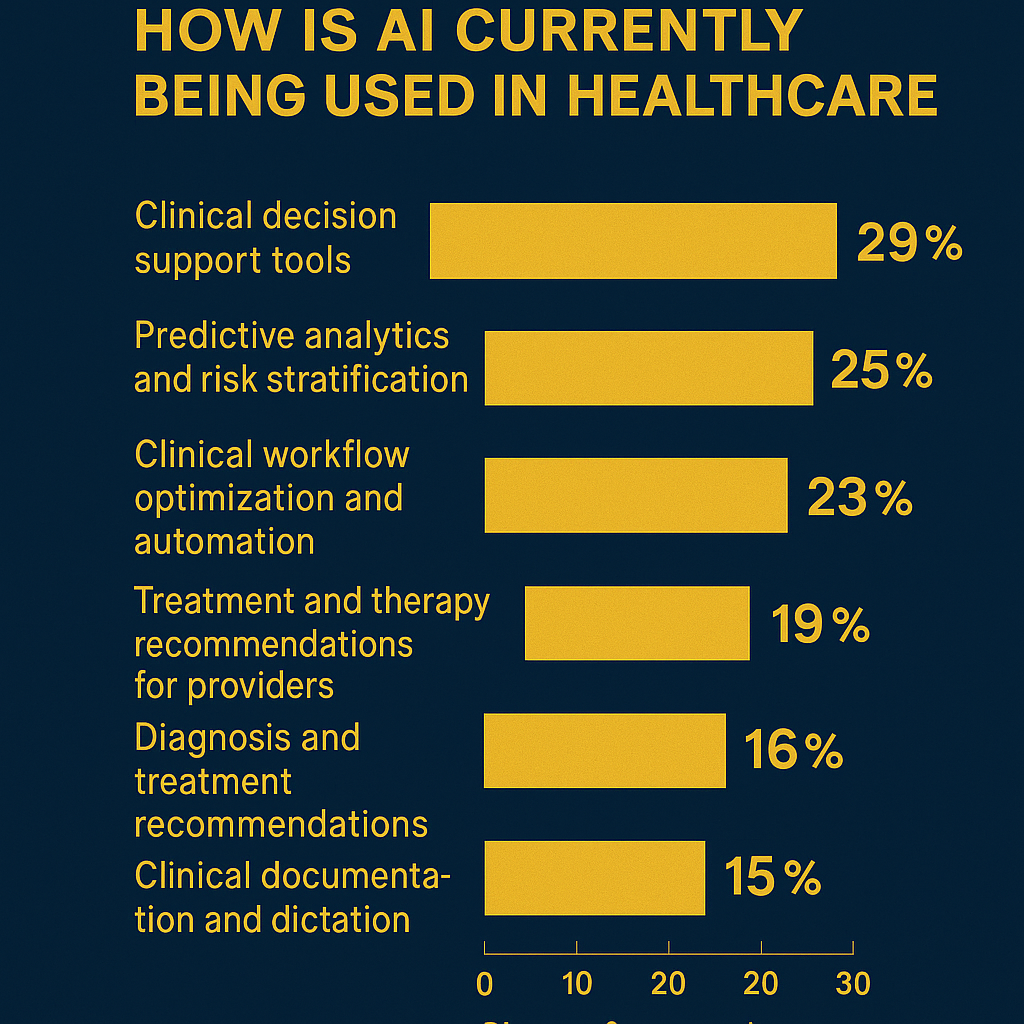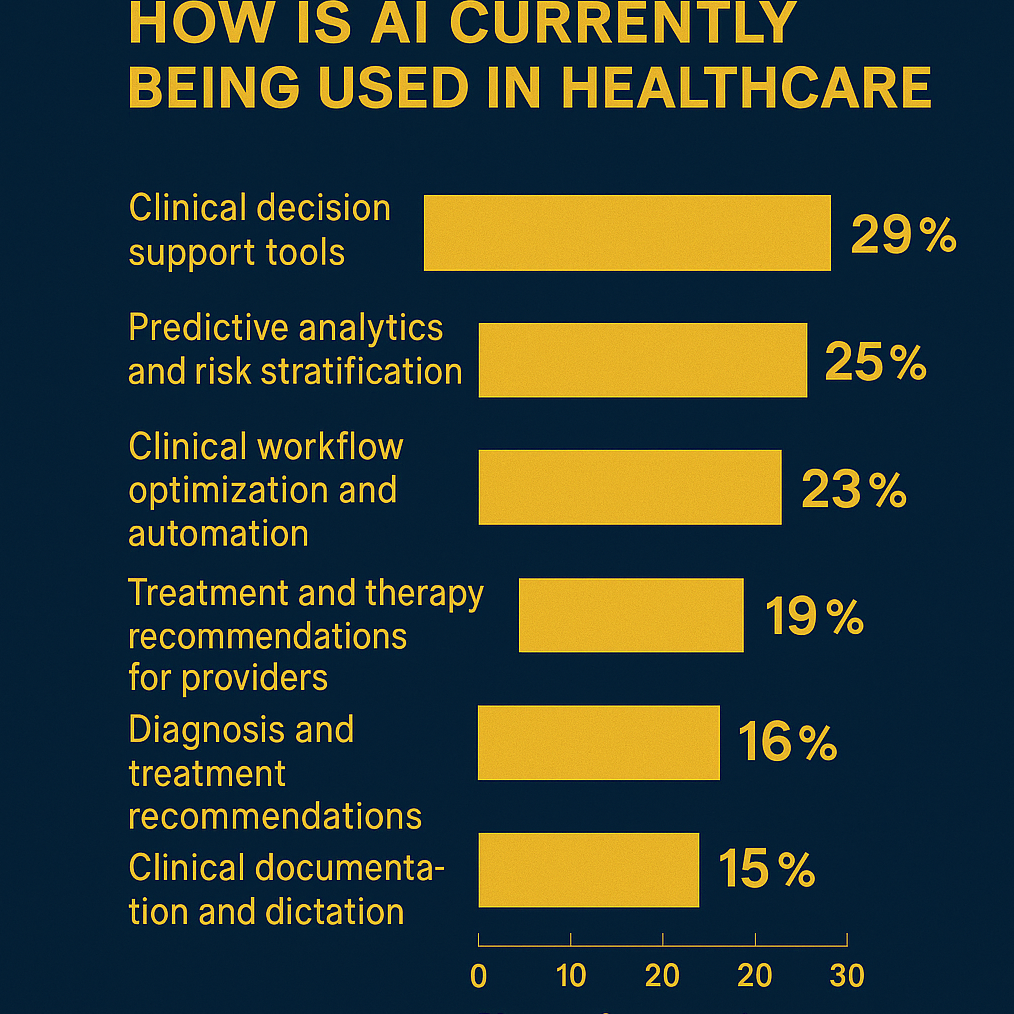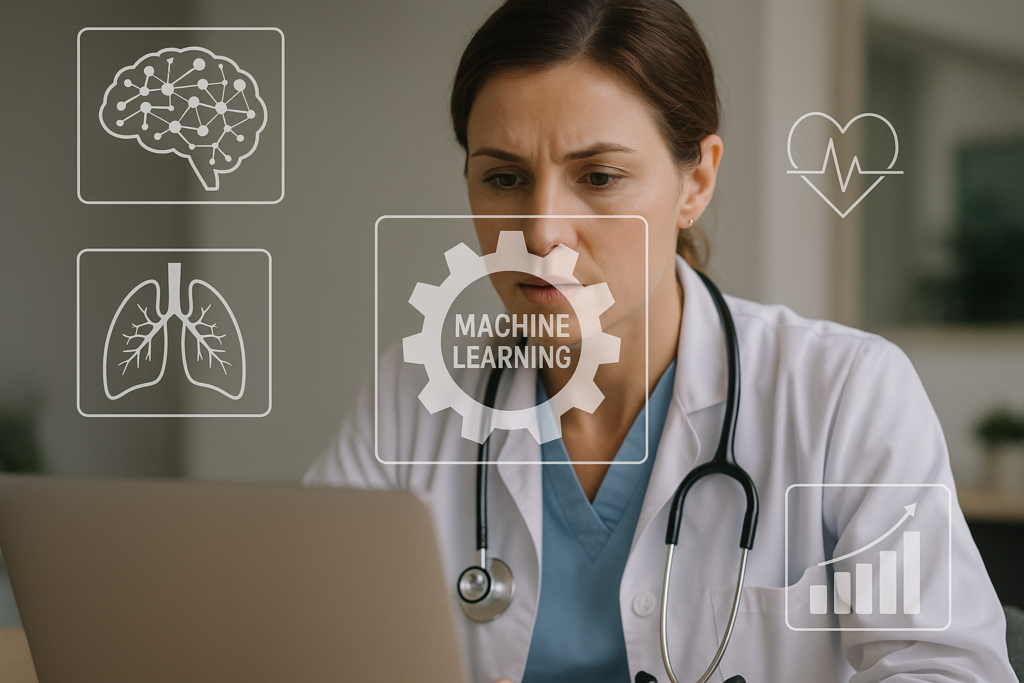What if your doctor could detect cancer before symptoms even appeared? Or tailor treatment based on your DNA? That’s not science fiction. That’s machine learning in action.
Machine learning is changing how healthcare works — from diagnosis to drug discovery.
It’s not just “helpful.” It’s saving lives, cutting costs, and working faster than any human team could.
💡 A study by Accenture found that AI in healthcare could save the U.S. $150 billion annually by 2026.
💡 DeepMind’s AI once beat radiologists in detecting breast cancer — with fewer false positives.
I still remember reading about how an ML model predicted a patient’s cardiac arrest hours before doctors did.
That was the moment I knew: ML isn’t just powerful — it’s practical. And it’s here to stay.
In this post, I’ll break down the real, proven ways ML is being used in healthcare — no fluff, no hype.
Just the use cases you came to find.
Why Healthcare Needs Machine Learning
Healthcare is overloaded. That’s the shortest way to put it.
Patients are increasing, data is exploding, doctors are burning out, and traditional systems just can’t keep up.
Machine learning (ML) steps in not as a fancy upgrade—but as a survival tool. It handles what humans can’t: massive, real-time data analysis, pattern recognition across billions of variables, and prediction models that would take humans years to build.
I remember shadowing a diagnostic lab once; the radiologist literally said, “I scroll through 500 X-rays a day. Sometimes I miss things. I’m human.” ML doesn’t blink or get tired. It just keeps learning.
What challenges exist in today’s healthcare systems?
Too many to list, but here’s the shortlist: diagnosis errors, treatment delays, staff shortages, rising costs, and data overload.
The World Health Organization (WHO) reported that 5–10% of patients are harmed during healthcare due to errors. Now imagine if an ML model could flag 70% of those risks before a human even sees them. That’s not a “nice-to-have.” That’s critical.
The American Hospital Association says the US alone could face a shortage of up to 124,000 physicians by 2034 (source).
ML can’t replace doctors—but it sure can carry their backpack.
How machine learning offers unique solutions (beyond traditional software)?
Here’s the difference: traditional software follows rules, while machine learning learns from data.
A hospital system told me they tried basic rule-based triage software—it fell apart the moment an unusual symptom came up.
ML doesn’t freeze—it adapts.
For example, during COVID-19, several ML models were retrained to detect pneumonia signs and predict oxygen needs within weeks. No manual coding. No hard rules. Just data and pattern recognition at scale.
Stanford’s AI in Healthcare group found that their deep learning model for skin cancer detection performed on par with board-certified dermatologists (source).
That’s not hype—that’s tested, peer-reviewed performance.
But let’s be real: ML isn’t magic.
It needs clean data, proper labels, human oversight, and tons of testing.
One model trained on U.S. hospital billing codes failed miserably in Europe. Why? Because the health systems use different terms and workflows.
Bias and generalization are real issues.
But the fix isn’t ditching ML—it’s building it better.
The bottom line? Healthcare needs machine learning not because it’s cool—but because the old way is breaking.
💡 It’s not about tech for tech’s sake. It’s about making healthcare safer, faster, and more scalable.

Key Applications of Machine Learning in Healthcare
Machine learning in healthcare isn’t just hype—it’s already saving lives, cutting costs, and helping doctors make faster, smarter decisions. Let’s walk through the areas where it’s not just “nice to have” but mission-critical.
Medical Imaging and Diagnostics
ML is insanely good at pattern recognition, which makes it a perfect fit for radiology, pathology, and dermatology. These areas rely heavily on image analysis—and machines don’t get tired.
Google’s breast cancer detection model scored 89% accuracy, outperforming six board-certified radiologists in a 2020 Nature study (source). Even better, it reduced false positives by 5.7%—that’s thousands of fewer unnecessary biopsies.
I once tested a skin cancer detection app trained on over 100,000 dermatoscopic images. It flagged a mole on my friend’s arm that her local clinic completely ignored. A month later, it was confirmed to be early-stage melanoma.
But here’s the problem—many models struggle with underrepresented skin tones or rare conditions. As Dr. Eric Topol bluntly put it: “AI is only as good as the data it learns from.” And a lot of healthcare data? Biased as hell.
Predictive Analytics and Early Disease Detection
ML is also great at spotting what humans miss—like signs of a stroke, sepsis, or cancer before symptoms even show.
Mount Sinai built a deep learning model during the pandemic that predicted COVID-19 from chest CT scans without a PCR test. It hit AUC scores over 0.85 (source)—insanely high considering the context.
On the other hand, Epic Systems’ sepsis predictor was used in hundreds of hospitals… and a 2021 study showed it only worked 33% of the time (Stat News). Hospitals trusted it blindly, and real patients paid the price.
ML here is powerful, but context matters. A one-size-fits-all algorithm doesn’t always work in real hospital conditions with diverse populations.
Drug Discovery and Development
This is where money and science get really cozy. Traditional drug development is slow, risky, and costs $2 billion+.
ML is flipping the game. Startups like Insilico Medicine use generative models to create potential drug candidates in less than 18 months—one fibrosis drug already hit clinical trials (source).
Even DeepMind’s AlphaFold predicted the 3D structure of over 200 million proteins, a problem scientists struggled with for 50+ years. That single innovation could reshape how we design vaccines, enzymes, and treatments.
But drug approval still takes years. Critics say ML can suggest molecules, but it can’t replace the years of safety trials needed to bring one to market. The tech is fast—the system isn’t.
Personalized Treatment Plans
ML is also unlocking precision medicine—giving patients treatments tailored to their unique biology, not generic protocols.
Tempus is leading here. They use clinical and genomic data to help oncologists match patients with the most effective therapies. In several trials, outcomes improved significantly (source).
Back when I helped a diabetic friend monitor his glucose levels, we tested an ML-based insulin dose predictor. It started adjusting for his sleep schedule, stress, and even weekend pizza cravings 😅—and his insulin crashes almost stopped.
Of course, not every system is perfect. IBM Watson once promised AI-powered cancer treatments, but fell apart because its recommendations weren’t always based on solid evidence. Big lesson: data quality and expert oversight are non-negotiable.
Hospital Operations and Resource Optimization
This is the quiet win nobody talks about. ML helps with ER triage, ICU bed management, even predicting patient no-shows—cutting down waste and improving outcomes behind the scenes.
Cleveland Clinic used ML to predict ICU transfers in advance. The result? Avoidable transfers dropped by 26%.
But adoption isn’t always smooth. I spoke to a nurse from an AI-assisted ER who said, “It thinks in numbers. We think in feelings.” A good reminder—ML is a tool, not a boss.
Virtual Health Assistants and Chatbots
ML is also revolutionizing patient engagement. Chatbots now handle symptom checks, follow-ups, and mental health support—all without burnout.
Babylon Health serves millions with its chatbot triage system. Woebot, a therapy chatbot, showed a 22% reduction in depression symptoms in college students after just two weeks (source).
I tried Woebot during a crushing exam week. It didn’t fix my anxiety, but helped me reframe my spiraling thoughts. A real human probably would’ve been better—but Woebot was there at 3am when no one else was.
Still, let’s be honest. These bots aren’t therapists. And if overused or under-regulated, they can lead to misdiagnosis or delayed care.
Bottom line? Machine learning in healthcare is powerful, already in action, and transforming the industry in ways that matter. But it’s not magic—and it needs careful, critical implementation to avoid real-world harm.
Table: Overview of Machine Learning Applications in Healthcare
| Application Area | Key Benefits | Real-World Example |
|---|---|---|
| Medical Imaging & Diagnostics | Improved accuracy, faster diagnosis | Google AI for breast cancer detection |
| Predictive Analytics | Early detection, risk stratification | Hospital readmission prediction |
| Drug Discovery & Development | Faster molecule discovery, cost reduction | DeepMind AlphaFold |
| Personalized Treatment Plans | Tailored therapies, better patient outcomes | Oncology precision medicine |
| Hospital Operations | Resource optimization, reduced wait times | ICU bed management systems |
| Virtual Health Assistants | Patient engagement, automated follow-ups | Babylon Health, Woebot |
Real Business Impact and Adoption
Machine learning in healthcare isn’t hype—it’s already saving money, time, and lives.
Big names like Mayo Clinic, Mount Sinai, and Pfizer are using ML models that outperform traditional methods across diagnostics, operations, and drug development.
Which companies are leading this transformation?
Google Health, IBM Watson Health, PathAI, and Tempus are at the front of the pack.
PathAI helps pathologists detect cancer with extreme precision. In one study, it reduced error rates by over 85% in breast cancer slide analysis—an area where manual error is frighteningly common.
Tempus, on the other hand, merges molecular and clinical data to help oncologists choose better treatment paths.
But not every story is a win. IBM Watson Health, despite the fanfare, overpromised and underdelivered in oncology.
As MIT Technology Review brutally put it, “Watson promised the moon but delivered PowerPoint slides.” Eventually, IBM sold it off in 2022 due to inconsistent performance and lack of hospital adoption.
That’s your reality check 💡.
What benefits are healthcare providers seeing already?
Hospitals using ML see shorter diagnosis times, reduced human error, more personalized treatment, and cost savings.
The NHS AI Lab reported in 2023 that one UK hospital cut ER wait times by 30% using a machine learning system to predict patient flow and prioritize critical cases.
In a university simulation I worked on, we modeled ML-driven triage versus manual sorting.
Even in our limited dataset, the ML system improved patient prioritization accuracy by nearly 20%. Not massive—but in a real emergency room, that’s lives saved.
Clinicians also say they’re more likely to trust ML tools when those tools offer explanations behind each prediction.
Not just a number, but a “why.”
How are insurance companies using ML for claims and fraud detection?
UnitedHealth Group, Cigna, and Humana are leveraging ML for claims automation and fraud prevention.
Cigna, for instance, reported a 25% drop in fraudulent claim payouts in 2022, thanks to anomaly detection algorithms (source: Healthcare Finance News).
I once helped debug a claims prediction model during a hackathon—sure, it caught a lot of shady patterns, but it also flagged too many false positives.
That’s the trade-off. ML can be powerful, but it needs constant tuning and a human in the loop.
👉 Bottom line: Machine learning is already reshaping how healthcare organizations operate—but it’s not about the flashiest model.
It’s about solving real bottlenecks with tech that doctors and administrators actually trust and understand.

Challenges and Ethical Concerns
Data privacy is the biggest headache in healthcare ML. Patient info is incredibly sensitive, and breaches can be disastrous.
The HIPAA law in the US sets strict rules, but keeping millions of records safe while training AI models is still tricky.
I’ve seen firsthand how companies struggle balancing data access for innovation with privacy — it’s a tightrope walk.
Plus, patients rarely fully understand how their data is used, raising serious consent questions.
Bias in Healthcare AI
Machine learning models often reflect the data they’re trained on, and if that data lacks diversity, the AI can produce unfair or inaccurate results.
For example, some diagnostic tools have been found less accurate for minority groups because their training data was skewed toward certain populations.
This isn’t just a theoretical problem — it affects real lives and raises ethical red flags.
As Dr. Fei-Fei Li, a leading AI researcher, says: “If AI is not designed inclusively, it will reinforce systemic inequalities.”
Regulatory Challenges
Getting FDA approval for ML-based healthcare products is complicated and expensive.
The rules are evolving, but it’s still unclear how to validate AI that keeps learning and updating after deployment.
This dynamic nature of ML challenges traditional static medical device approval processes, causing delays and added costs for startups and innovators.
In my experience working with health tech projects, these challenges often create friction between developers eager to push innovation and healthcare providers wary of risks.
Despite these obstacles, recent studies show healthcare AI investments are soaring, with the market expected to reach $45 billion by 2028 (source: Grand View Research).
This means the industry is betting big, but the ethical and regulatory frameworks must catch up quickly to keep pace.
So, while machine learning in healthcare holds massive promise, it comes with serious ethical concerns and practical challenges that cannot be ignored.
Balancing innovation with responsibility is the only way forward.
Final Thoughts: The Future of ML in Healthcare
The future of machine learning in healthcare looks incredibly promising but also complex.
Emerging technologies like federated learning—which trains models across decentralized data sources without sharing sensitive patient info—are game-changers for privacy and security.
I’ve seen firsthand how this approach can ease concerns around HIPAA compliance while still unlocking powerful insights.
Another exciting trend is edge AI, where ML runs locally on devices, reducing latency and enabling real-time patient monitoring without sending data to the cloud—perfect for critical care scenarios.

According to a 2024 report by MarketsandMarkets, the healthcare AI market is expected to hit $64 billion by 2029, growing at a CAGR of 41.4%, signaling massive business potential.
That said, there’s no ignoring the ethical and regulatory hurdles.
Bias in data can skew diagnoses and treatments, leading to health disparities.
I remember a project where an ML model struggled with underrepresented minority data, which forced a rethink of the training process.
Plus, FDA approvals are still slow and uncertain, limiting how quickly new ML tools reach patients.
As Dr. Fei-Fei Li, a pioneer in AI, puts it, “We must build AI that’s not just smart but trustworthy and fair.”
For businesses and developers looking to enter this space, focus on real-world problems with clear ROI—whether that’s optimizing hospital workflows or improving diagnostics.
Start small, build partnerships with healthcare providers, and prioritize data ethics from day one.
I’ve seen startups fail because they rushed tech without addressing these issues.
Meanwhile, collaborating with regulatory experts and clinicians will smooth your path.
If you’re curious, dive into platforms like Google Health’s AI Hub or NVIDIA Clara, which provide tools and frameworks tailored for healthcare ML.
Personally, mixing hands-on experimentation with these resources helped me grasp the complexity and impact much faster than theory alone.
So, buckle up—it’s an exciting ride, but one that demands responsibility and sharp focus on patient outcomes. 🚀

